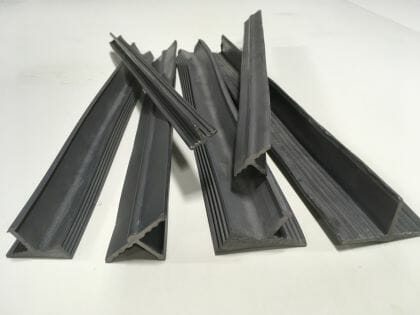
T caps are perfect for the inclement wet weather and harsh winters of New England and the northern states.
If Leakage and moisture penetration is caused by building movement or settlement with resultant “joint checking”, your stone caulk/sealant needs some assistance. Unknown building movement is among the primary causes of joint caulk/ sealant failure. To specify a particular caulk/sealant, owner/architect must determine the extremes of joint movement. Sealant manufacturers offer scribe kits to make these determinations and calculations.
Caulking/sealing a stone joint does not remove or compensate for movement or settlement of a building. It is suggested the interposition of T-Caps in caulked/sealed joints to take the abuse of such stress is in order; and the T-Cap being and adjunct to the caulk/sealant reduces the size of the opening of a joint to be caulked/sealed to assure improved, long lasting leak free joints.
Interpose T-Caps in your caulked/sealed joints. The selection of proper sized T-Cap is controlled by measurement of the joint opening to be caulked/sealed plus maximum percentage of joint movement experienced per scribe test plus 1/4 inch. The a fore stated is the sum size of the outer dimensions of each T-Cap as installed.
T-Caps are a soft lead strip which when set and bedded in caulking compound/sealant, forms a cap which assures a permanent elastic seal for any masonry joint. After installation, the surface oxidizes rapidly to a neutral grey which blends with the masonry.
Installation Locations
- Top, side and cross joints of copings and balustrades. Extend from outer face, across the top of the coping and down parapet side.
- All cross joints on cornices and belt courses. Carry down at least 1 inch on front face of stone, or down front face of stone to first change in contour as desired.
- All cross top joints on window and door lintels, entrance porticoes, brackets, pilasters, water tables and any other piece of masonry which projects beyond the face of the building.
- The joint at the top of all projecting window or door lintels, entrance porticoes, brackets, pilasters and any other masonry projections where those units join side wall or parapet at approximately right angles.
- All joints between sill of window frame and masonry supporting sill.
- All joints around plain or ornamental window and door frames
- All right angle joints on building entrance steps where the treads and risers meet, and where treads and risers join stringers.
- All joints around perimeter of glass block windows or panels.
Standard Extruded Lead T-Caps – Sizes in Stock (Specials upon request):
Type A Flat Cap
| Width | Joint Depth | Packaging |
|---|---|---|
| 1/2" | 7/16" | 25# (Ref: 75') spool(s) |
| 11/16" | 1/2" | 25# (Ref: 60') spool(s) |
| 1" | 11/16" | 25# (Ref: 40') spool(s) |
| 1 1/4" | 3/4" | 25# (Ref: Three 7' long lengths) |
| 1 1/2" | 13/16" | 25# (Ref: Three 7' long lengths) |
| 2" | 15/16" | 25# (Ref: Two 9' long lengths) |
Type B Corner Cove Cap
| Width | Joint Depth | Packaging |
|---|---|---|
| 1/2" | 7/16" | 25# (Ref: Four 8' long lengths) |
| 11/16" | 1/2" | 25# (Ref: Three 8' long lengths) |
| 1" | 11/16" | 25# (Ref: Two 8' long lengths) |
| 1 1/2" | 13/16" | 25# (Ref: One 8' long length) |
| 2" | 15/16" | 25# (Ref: One 8' long length) |
Additional Characteristics
- Size of masonry joint is by ½ when T-Cap is interposed in a joint between sealants.
- T-Caps remain flexible and are paintable.
- T-Cap will not tear nor shear and resists corrosion.
- T-Cap covers the sealant, thereby prolonging life and preventing margin checking.
- T-Cap is not a conductor of heat & cold; it resists mold attack on covered sealant in high humidity areas.
- Stress to copings atop parapets, as well as, right angle junctions of two walls, are buffered by the T-cap.
- Other properties of T-Cap are, it is low in tensile strength, hardness, elastic modulus, and creep strength. Because of these, and the other characteristics listed above, after a building movement, the low creep strength causes the lead to creep into new the configuration. Temperature change accelerates this creep movement. The low elastic modulus allows this process to continue indefinitely within the joints design limits. Other metals would retain their original shape and permit moisture into the joint.
For a complete listing of products available on this site, go to the products and services index page